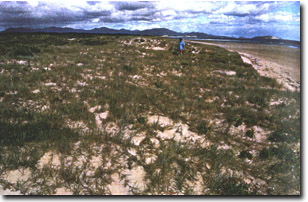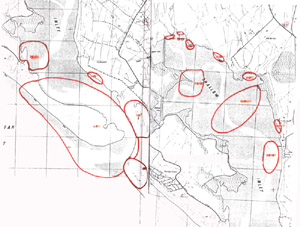2. South-Eastern Side of Entrance
This information has been developed from the publication:
|
| Location | 295870 Beach ridges and terrace, active dunes and calcarenite outcrops on south-eastern side of Shallow Inlet entrance channel. |  High Spinifex terrace on eastern side of Shallow Inlet entrance |
Access: | Boat access from Sandy Point or walk from Shallow Inlet Road camping area. | |
Significant Features: | There is a high foredune terrace and low ridged foredunes crossed by a number of small blowouts and unusual circular blowout hollows. The blowouts expose calcarenite pavements and inland of the newer dunes is a cliff (Red Bluff) a former coastal cliff. The terrace is dominated by Spinifex with low Acacias and is a rare example of this type of coastal progradation. Circular and u-shaped blowouts show sections of the terrace sand to be fine and horizontally bedded without conspicuous aeolian bedding or slipfaces. | |
Significance Level: | State. The site is one of contrasts showing erosion by tidal current as well as waves along the channel and accretion of an unusually wide and high (2 metres) foredune terrace on the ocean cost. The site is of significance for studies of foredune accumulation and the respective roles of wave, swash and aeolian deposition. The area has important association with notable geological features i.e. Stirling, Ferguson who remarked on the calcareous dunes (Red Bluff) at the entrance. | |
Management Issues: | The site is relatively inaccessible and not threatened by visitor overuse. It is a highly dynamic site with rapid erosion and deposition associated with channel migration and needs to be viewed in conjunction with the dynamics of the entrance spit. Because of the sensitive nature of the dunes, it is best not to encourage visitors to this side of the entrance as scrambling up the face of the foredune terrace will initiate blowout troughs. | |
Research & Monitoring Requirements: | The surveying of profiles initiated by Cecil (1983) should be revived, extended or replaced as necessary. This survey should be designed to provide quantitative data concerning the rates of entrance migration and should include channel sounding and mapping of entrance bars. The vegetation changes of the foredune terrace should be monitored. | |
Public Interpretation Possibilities: | Serial maps and aerial photographs up-dated annually to show entrance dynamics in the context of historical changes. | |
Main References: | Smith, A. S. (1969). 'The geomorphology of Shallow Inlet, Victoria.' B.Sc. (Hons) Thesis. Dept. of Geography. Univ. of Melb. Cecil, M. K. (1983). 'The evolution of the entrance to Shallow Inlet.' Geol. Surv. Vict. Unpub. Rept. 1983/71. | |



